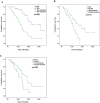P53 nuclear stabilization is associated with FHIT loss and younger age of onset in squamous cell carcinoma of oral tongue
- PMID: 25152695
- PMCID: PMC4141988
- DOI: 10.1186/1472-6890-14-37
P53 nuclear stabilization is associated with FHIT loss and younger age of onset in squamous cell carcinoma of oral tongue
Abstract
Background: Squamous cell carcinoma of tongue (SCCT) is expected to harbor unique clinico-pathological and molecular genetic features since a significant proportion of patients are young and exhibit no association with tobacco or alcohol.
Methods: We determined P53, epidermal growth factor receptor, microsatellite instability, human papilloma virus infection and loss of heterozygosity status at several tumor suppressor loci in one hundred and twenty one oral SCCT (SSCOT) samples and analyzed their association with clinico-pathological features and patient survival.
Results: Our results revealed a significantly higher incidence of p53 nuclear stabilization in early (as against late) onset SCCOT. FHIT loss was significantly associated with p53 nuclear stabilization and the association was stronger in patients with no history of tobacco use. Samples harboring mutation in p53 DNA binding domain or exhibiting p53 nuclear stabilization, were significantly associated with poor survival.
Conclusion: Our study has therefore identified distinct features in SCCOT tumorigenesis with respect to age and tobacco exposure and revealed possible prognostic utility of p53.
Keywords: Disease specific survival; EGFR; FHIT; Oral tongue cancer; TP53.
Figures


References
-
- Iype EM, Pandey M, Mathew A, Thomas G, Sebastian P, Nair MK. Oral cancer among patients under the age of 35 years. J Postgrad Med. 2001;47:171–176. - PubMed
-
- Silverman S Jr. Demographics and occurrence of oral and pharyngeal cancers. The outcomes, the trends, the challenge. J Am Dent Assoc. 2001;132 Suppl(132 Suppl):7S–11S. - PubMed
LinkOut - more resources
Full Text Sources
Other Literature Sources
Research Materials
Miscellaneous

